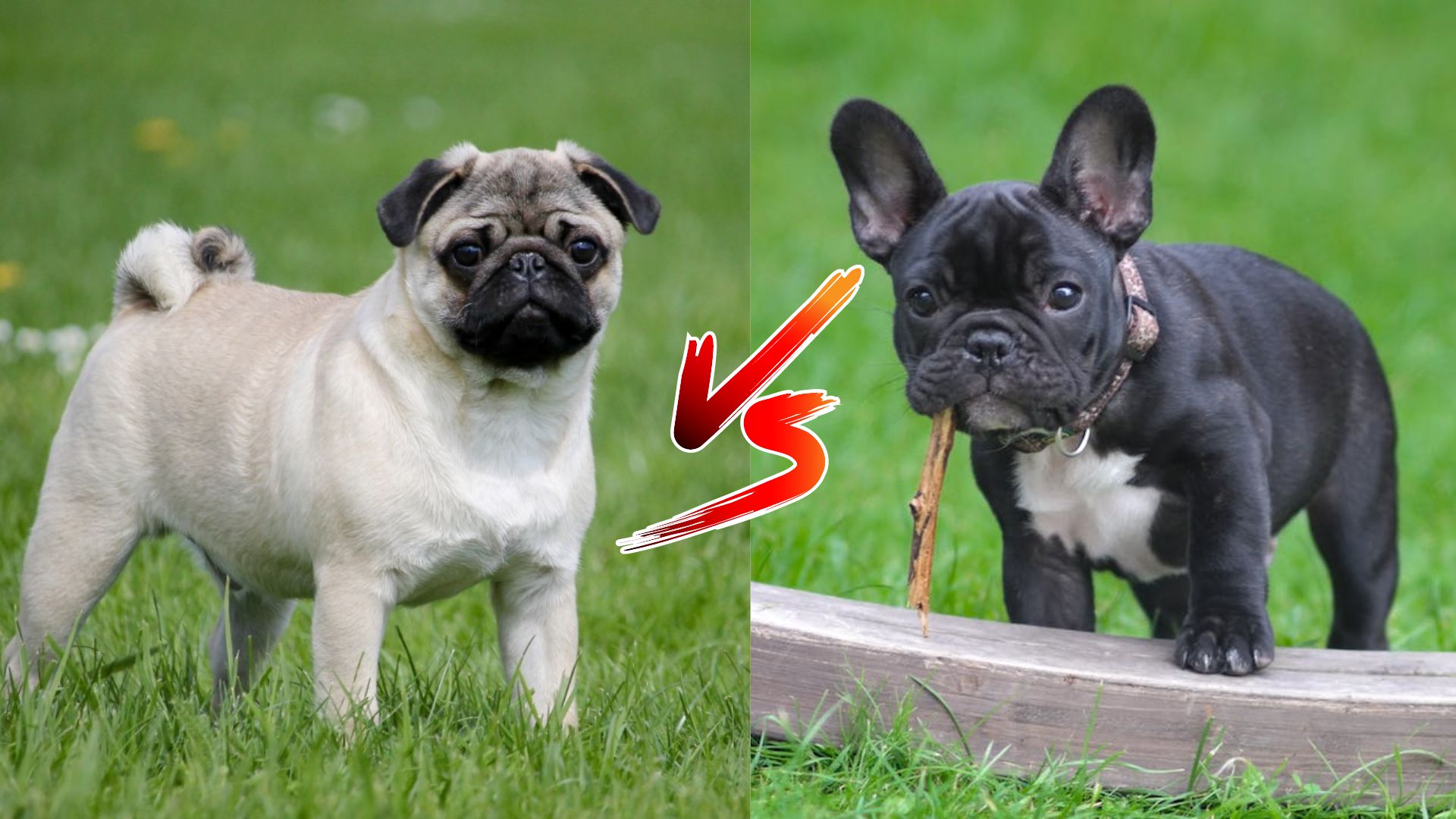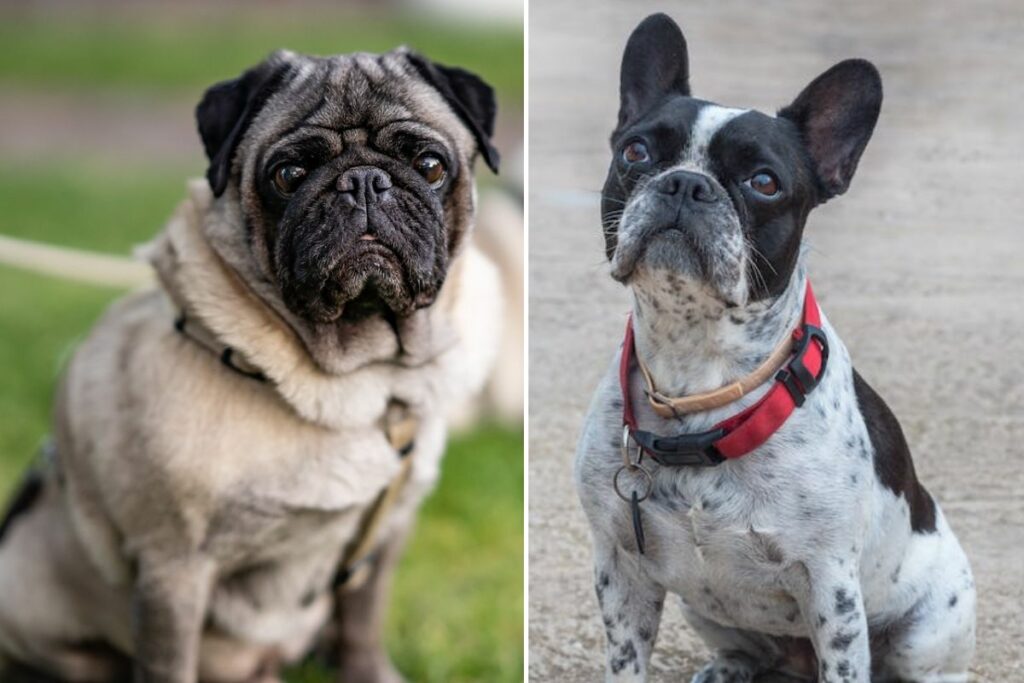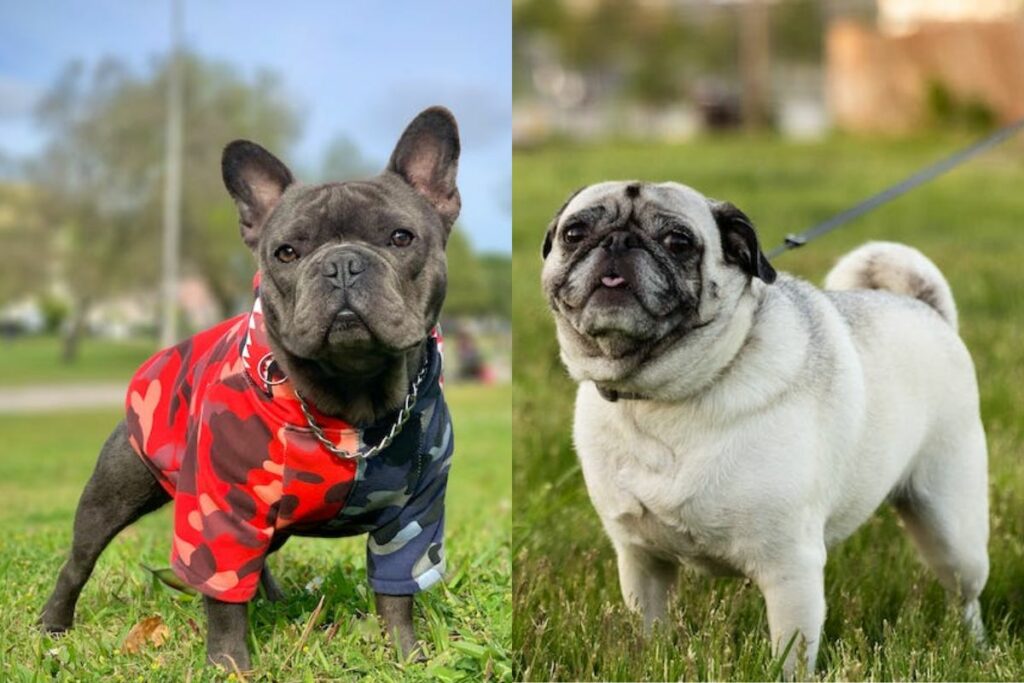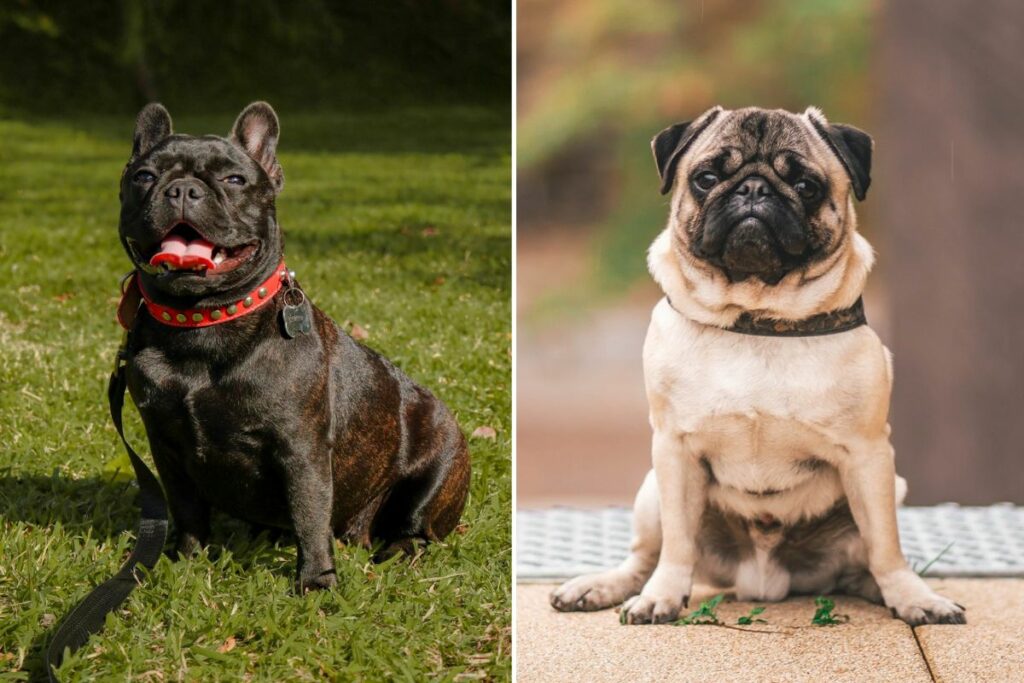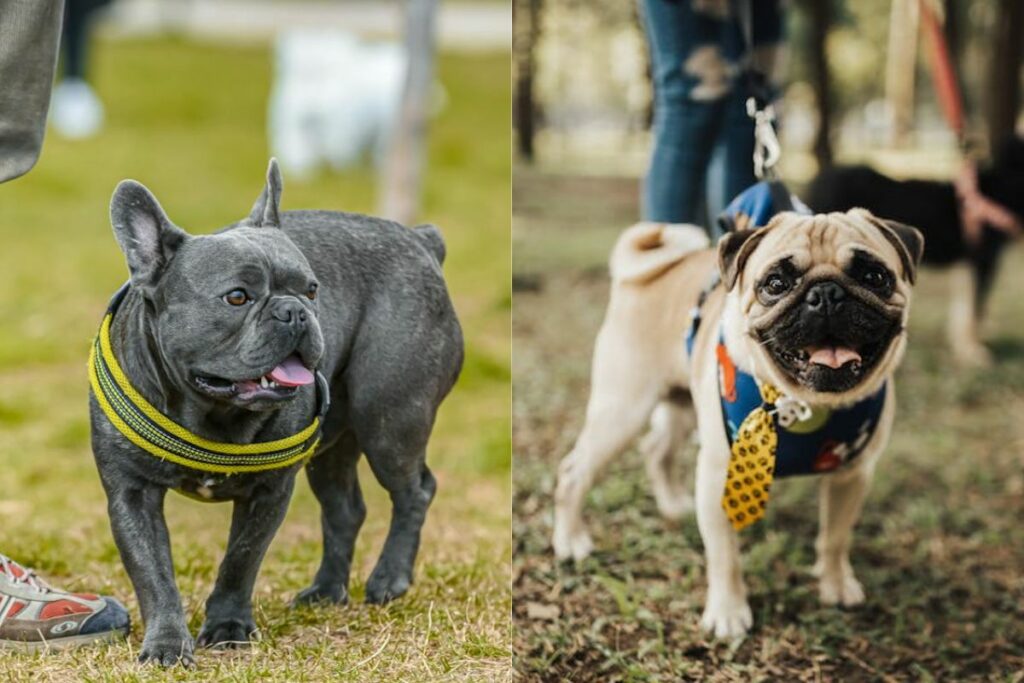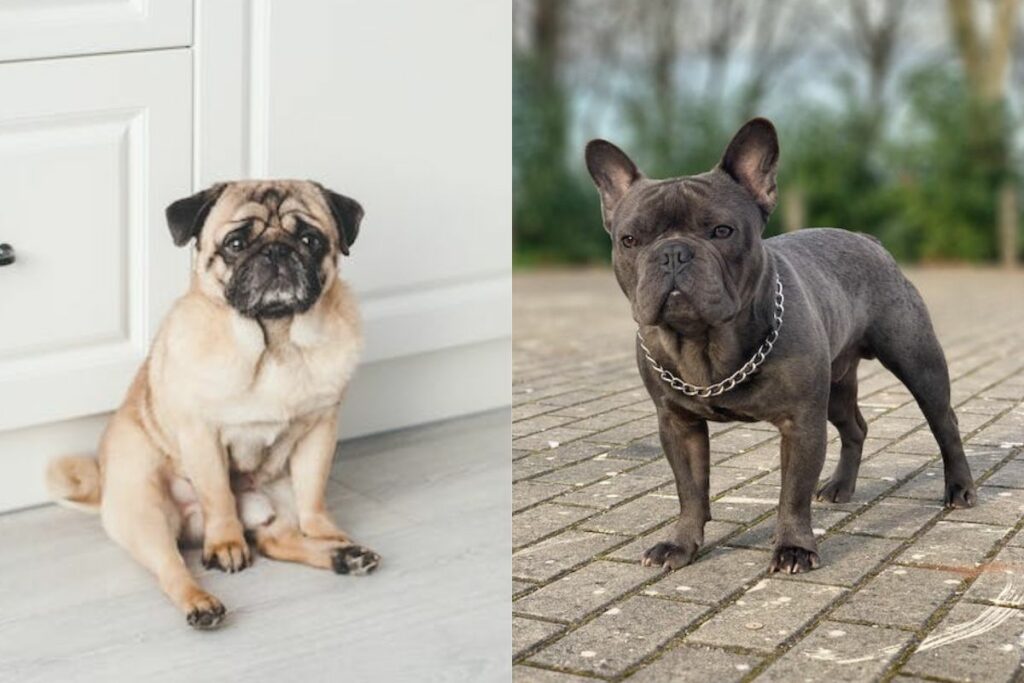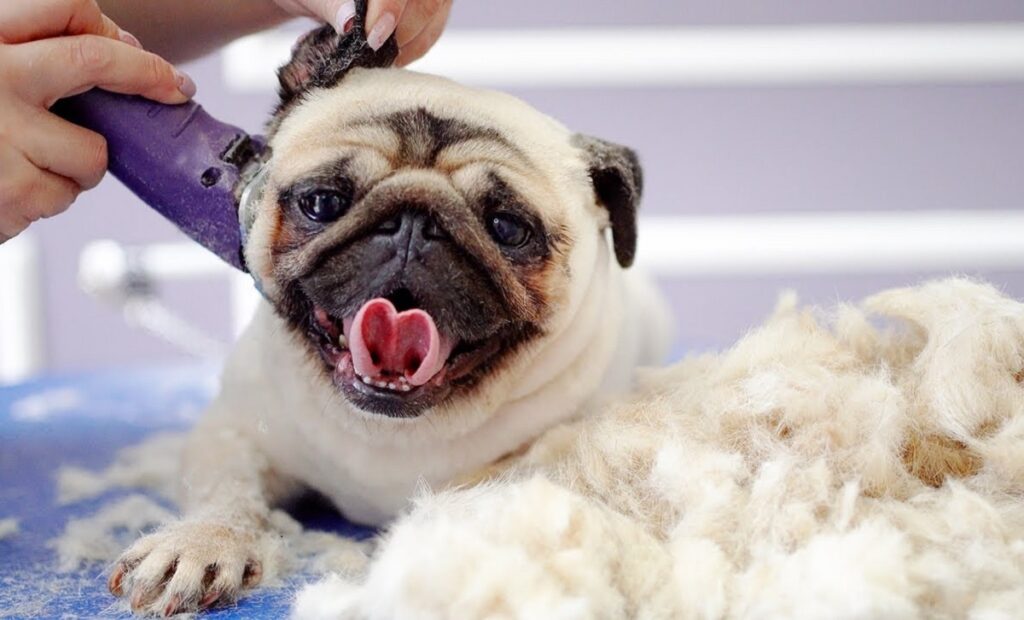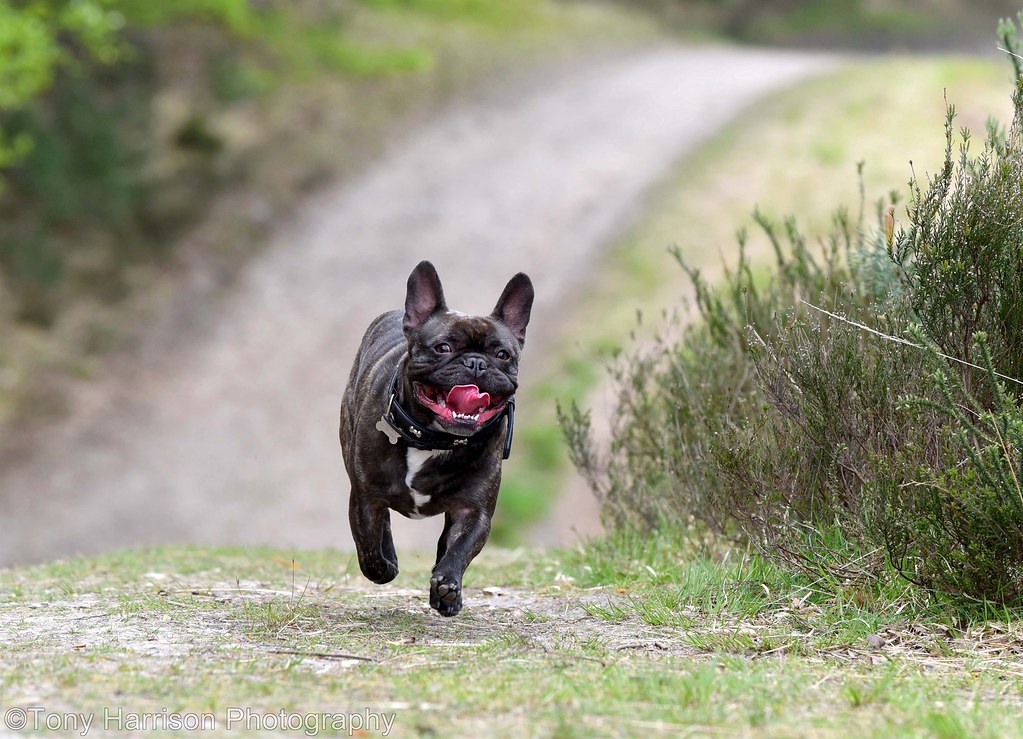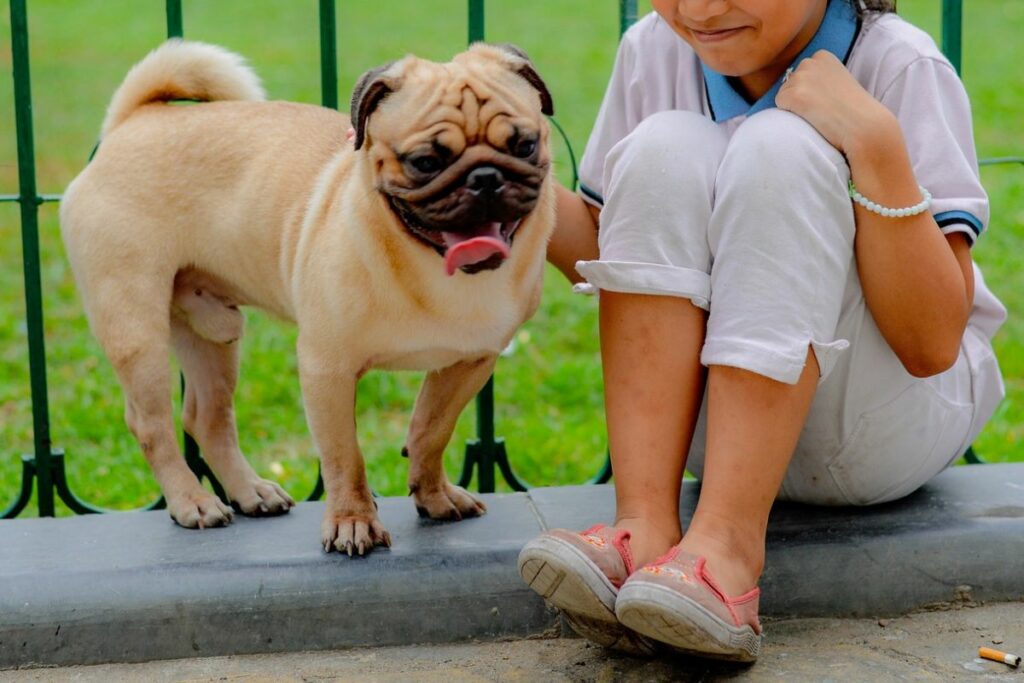Pugs and French Bulldogs. Wrinkly, adorable, and utterly captivating, these breeds often get confused. But beneath the charming snorts and curled tails lie key differences. From personality quirks and exercise needs to health concerns and grooming routines, choosing between a Pug and a Frenchie is a big decision. This guide dives deep into the distinct characteristics of each breed, helping you determine which of these charismatic companions is the perfect fit for your lifestyle. Ready to uncover what sets these two breeds apart?
I couldn’t wait to jump into this assignment as soon as I heard I’d be writing about two of the most adorable dog breeds there are. We’ll talk about the differences and similarities between Pug vs. French bulldog.
But as much as I’d love this article to be all unicorns and rainbows, it’s imperative we also discuss the difficulties these breeds face just to exist. I’m talking about Brachycephaly, and we’ll get into what that entails.
The French bulldog is so well loved it knocked the Labrador retriever out of the number one spot on the Most Popular Dog list (AKC) in 2022. Quite a feat! The Pug is also quite popular and was number 35 out of a list of 199 dogs on the 2022 list.
Let’s talk about the Pug vs. French bulldog and what makes them so wonderful.
Brachycephaly in Pugs and French Bulldogs
If you’ve never seen a pug or “Frenchie,” you’re missing out. Their flat faces, wrinkles, and soulful eyes will make you go running home to say, “We need a dog!” But along with that preciousness comes tragedy… Brachycephaly.
Brachycephalic Obstructive Airway Syndrome (BOAS) is a chronic, debilitating, lifelong disease that makes it difficult to breathe. That’s right, when you hear a pug or a Frenchie making those cute snuffles and snorts, they’re probably trying to get a good breath.
The disease affects many popular canine breeds, including Boston terriers, Pekingese, and Shih Tzus, among others. These brachycephalic dogs have a shortened skull, flat face, and “snub nose.”
But this quest for cuteness by selective breeding has resulted in cutting a dog’s quality of life into smithereens. This disease can also cause bronchial collapse, gastroesophageal reflux, and chronic gastritis, among other issues.
Over time, breeders have strived to produce flatter faces (over successive generations) to make a cuter dog, and the results have been disastrous.
But we can do something about it. If we think twice, or three times, before going to a breeder for a flat-faced breed, we might choose to adopt instead, which is the better choice. It’s smarter to not perpetuate breeding.
Try one of these places to adopt a flat-faced breed:
- Your local humane society
- Your local rescue/shelter/animal sanctuary
- Breed-specific rescues (nationwide)
- Northshore Animal League – Reputable nationwide animal rescue
- American Kennel Club rescues – More than 450 AKC Rescue Network groups are located across the United States. (A wonderful service from the AKC.)
- Petfinder – An incredible organization that welcomes adopters
Interesting tidbits about a Pug vs French bulldog
- Some people call Pugs “Dutch bulldogs,” but bulldogs and pugs aren’t related. Although they have a few features that are alike, their origins are shared with the Pekingnese.
- Pugs have wrinkled faces because they were selectively bred that way initially by Chinese breeders.
- French bulldogs are considered great apartment dogs – they fit right in anywhere from apartment living to a farmhouse. They’re highly adaptable.
- They/Frenchies also have surprisingly powerful jaws, so shop for those Kong toys instead of the flimsy kind.
Pug vs French Bulldog: Key Differences
Let’s uncover their distinct traits and personalities to understand what sets these popular breeds apart.
History
PUGS – Initially developed in China, pugs served as pets in Tibetan Buddhist monasteries. They’ve been around since at least 400 BC and are one of the oldest dog breeds. Pugs were bred to be lapdogs for Chinese emperors, which is probably why they’re more sedentary than other breeds. (No hunting or pulling sleds from this ancient breed!)
Similar to other breeds, they were bred specifically for the emperors and their families, who loved flat-faced breeds, and outsiders could only be gifted one.
FRENCH BULLDOGS – It all began with the bulldog in England in the mid-1800s. Back then, lacemakers were plentiful, and bulldogs became their favorite companion. During the Industrial Revolution in England, many of those in the vocation moved to France with their small bulldogs by their sides.
Over decades, bulldogs were crossed with other breeds, and somewhere along the line developed their “bat ears,” which now make them highly recognizable. Paris eventually learned about the new breed, and by the end of the 19th century, the French bulldog had settled across all of Europe and America.
Size
- PUG:Height: 10”-13”Weight: 14-18 lbs.
- FRENCH BULLDOG:Height: 11”-13”Weight: 18-30 lbs.
Lifespan
- PUGS:13-15 yrs.
- FRENCH BULLDOGS:10-12 yrs.
Coat, markings, and color
PUGS: Smooth, short, single coated; Markings – Black mask; Colors: Black, fawn
FRENCH BULLDOGS: Smooth, short, single coated; Black markings, white markings, black mask, spotted, brindle markings, piebald, ticked, tan points; Colors: Brindle, brindle & white, cream, fawn, fawn & white, fawn brindle, white, white & brindle, black, fawn brindle & white, white & fawn, blue, chocolate
Appearance
PUGS – Pugs have:
- Solid bodies
- Flat faces with wrinkles
- Large heads
- Short, flat, black muzzles
- Tails that curl up to the back
- “Rose” and “Button” ears – The rose ear has a small drop, and it falls over and back. The button ear folds forward, with the tip lying close to the skull. The American Kennel Club (AKC) reports that button ears are preferred in conformation show rings.
- Protruding eyes (“Pop-eyes”)
FRENCH BULLDOGS – Frenchies have:
- Muscular bodies
- Heavy bone structure
- Flat faces with wrinkles
- Large heads
- Short, flat, solid, or multi-colored muzzles
- Short tails
- Erect, broad at the base, rounded at the top ears (Commonly called “bat ears”)
- Protruding eyes
Exercise and grooming
PUGS
Although they’d adore hanging out in your lap ad nauseam, pugs still require daily moderate exercise in the form of a short walk or quick spins in the backyard. Watch them carefully since they don’t need to get overheated or exercise in high humidity/heat due to their breathing issues.
Having said that, they enjoy participating in obedience, agility and rally canine sports that are generally held indoors and are temperature-controlled.
A pug’s short coat needs minimal maintenance except for a weekly brushing. Bathing them once every few months is fine unless they roll in, um… stuff. Pay close attention to their ears and eyes for any discharge or discomfort. Trim their nails monthly, and their facial folds/wrinkles should be kept clean and dry.
FRENCH BULLDOGS
Much like the pug, the Frenchie requires daily exercise, but don’t overdo it. Short walks or sprints in the backyard would work just fine. They also enjoy participating in the canine sports mentioned above.
Like the pug, a weekly brushing, monthly nail trim, and being alert to the condition of the ears and eyes will keep your pup ship-shape. Always keep folds clean and dry since bacteria and parasites can develop in those areas if left wet or dirty.
Personality
Highly affectionate, adaptable, and great with kids, families, other dogs, strangers, etc., these pugs are charmers. They’ll only bark to alert you of something; just don’t expect these little guys to be good guard dogs. They’re quite playful, and pugs tend to be mischievous, so if “something” shredded the bathroom tissue, you’d know where to look.
Adaptable, playful, good-natured, and alert, Frenchies will quickly steal your heart. These great pets get along with kids, seniors, other dogs, etc., and always want to be wherever you are, whether that’s at home or out and about. They have a steady, even personality and are a pleasure to be around.
I dog-sit a Frenchie who’s so adorbs and sweet, I could just put him in my pocket. They can have a stubborn streak, but it’s even cute!
Training
To begin with, obedience training and socialization (to new dogs, people, and things) needs to begin when they’re puppies and continue throughout their lives. An excellent place to go is to a dog obedience class so they can experience other dogs, people, and situations. They might even make a new furry friend.
Both the pug and the Frenchie make great companions and are highly trainable, so get them into dog sports or parks (the “Small dog” area) to stimulate them. Also, take them with you whenever you can to expose them to new sights and sounds. They can show some stubbornness, so be prepared to be consistent, using only positive reinforcement training.
Health
The number one health issue both of these breeds share is Brachycephaly. Brachycephalic breeds can present with scary symptoms. If they appear to be in distress with breathing problems, get them to a vet or animal hospital immediately.
Both breeds can also develop:
- Dental disease
- Bacterial and viral infections (Stay up to date with those vaccines.)
- Obesity
- Parasites
As always, spay or neuter your pups since it can decrease the likelihood of certain types of cancers and stop more unwanted animals from being born.
Genetic Predispositions For Pugs
- Liver problems
- Eye issues
- Diabetes
- Allergies
- Mange
- Skin infections
- Granulomatous Meningoencephalitis (GME) – Inflammatory disease that affects the central nervous system/brain.
- Bone and joint problems
- Spinal deformities
- Mast cell tumor (Skin cancer)
- Bladder or kidney stones
- Degenerative Myelopathy (DM)
Genetic Predispositions for French Bulldogs
Degenerative Myelopathy (DM) – This neurologic condition is especially close to my heart since the Frenchie I dog-sit, Ted, has it. One day, he started gradually losing the ability to move his hind legs and became incontinent. There is no cure. The sweetheart is still just as sweet as he ever was.
They Can Also Develop
- Back problems
- Spinal deformities
- Inflammatory Bowel Disease (IBD)
- Eye issues
- Allergies
- Patellar Luxation (Knee slipping out of place)
- Hip and elbow dysplasia
- Bladder or kidney stones
- Skin allergies/infections
Cost
PUG: Their price range is $800-$2,000+ depending on breeder location, pedigree, lineage, if it’s a show dog or not, and more
FRENCH BULLDOG: Frenchies cost $1,500-$3,000+ depending on breeder location, pedigree, lineage, if it’s a show dog or not, and more
What is a Frug?
A Frenchie/Pug hybrid (mixed) breed is called a “frug” by some. Although there’s no guarantee of what they’ll look like or what their temperaments will be, chances are they will be loyal, loving, and spunky. They’ll adore their people.
Frug:
- Height – 10”-12”
- Weight – 15-23 lbs.
- Lifespan – 9-15 yrs.
They probably originated in the 1900s and are significantly popular with those who want a hybrid breed. Frugs won’t need much exercise, just like their parents, but will still need physical and mental stimulation daily. Their coats will usually be short and smooth.
Which Breed will be Best for You: Pug or French Bulldog
The most important decision you can make is to adopt a pug or Frenchie. Other than that, you might want a specific color. With pugs, you have black or fawn to choose from, and with Frenchies, there are a myriad of colors and color combinations.
If you’re looking for a dog with wrinkles, pugs seem to have a more wrinkly look than Frenchies. Both French bulldogs and pugs are loving, affectionate, and smart, so you can’t lose with either one.
FAQs
What’s a Frenchie Pug and Puggle?
A Frenchie/Pug hybrid (mixed) breed is called a “frug” by some. A Puggle is a hybrid cross between pugs and beagles.
When Should I Start Training My Pug or French Bulldog?
You’ll want to start training pug or French bulldog puppies immediately upon adopting them. Hopefully, they’ve been weaned (read, able to be with their mothers), so at about 8 weeks old, they can begin to grasp commands.
Do French Bulldogs Have Health Issues Like Pugs?
Absolutely. Some predispositions to illnesses/diseases are the same, but some are unique to the breed.
Do Pugs Bark a Lot?
In general, no, but there’s no way for that to be definitive since every dog is unique.
Wrap Up
So now that you’ve stepped into the paws of a pug and a Frenchie, we hope you’ve learned something you didn’t know. Choosing a dog breed you’re happy with is of the utmost importance.
If you’ve already made the decision to purchase a dog, do your research to find a reputable breeder. Hopefully, you’ll want to rush to the rescue to adopt one. And be ready to be cuddled to death and entertained for years to come!
Ultimately, both Pugs and French Bulldogs offer unique charms. Pugs are the more comedic, laid-back choice, content with cuddling and less demanding of exercise. French Bulldogs, while equally affectionate, possess a playful energy and thrive on more activity. Choosing between the two depends on lifestyle and preference. Consider your living space, activity level, and tolerance for potential health concerns associated with each breed. With proper care, either breed can make a wonderful and loving companion.

